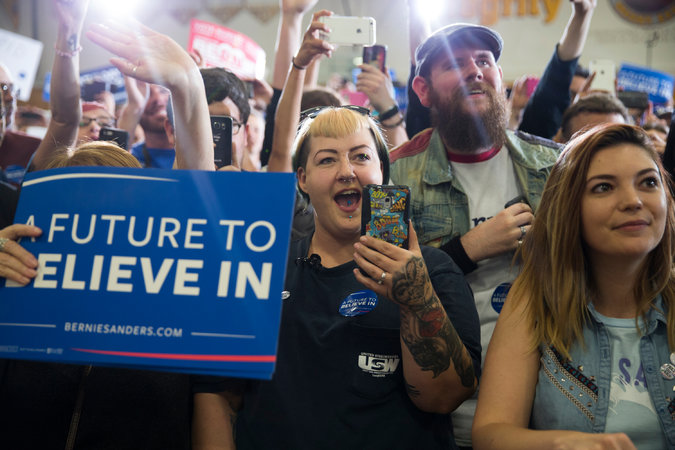In one of the more pleasant surprises of this presidential campaign, young Americans are voting in big numbers, contributing to some unexpected results so far.
This is the first presidential campaign in which people age 18 to 29 make up the same proportion of the electorate as do baby boomers — about one-third. This year, the youth turnout for both parties in the primaries so far is rivaling 2008, the year of Barack Obama’s first campaign. On Saturday, young voters turned out in far greater numbers in the South Carolina Republican primary than they did in 2008 or 2012 in that state, according to a study by Tufts University’s Circle center. Donald Trump won the primary, with 32.5 percent of the vote, but young voters were the only group he didn’t carry. Marco Rubio came in second with 22.5 percent, closely followed by Ted Cruz, with 22.3 percent. Both Mr. Cruz and Mr. Trump drew bigger share of the youth vote than Mr. Rubio.
The youth vote’s biggest beneficiary by far is Bernie Sanders, who filled venues in Las Vegas with cheering young admirers last week, after winning more than 80 percent of this group in both Iowa and New Hampshire. On Saturday young people made up 18 percent of voters in Nevada’s Democratic caucus, five percentage points more than in 2008. Mr. Sanders again drew more than eight in 10 of these voters. Mrs. Clinton won Nevada with 52.7 percent, besting Mr. Sanders by 5.5 percentage points. But young people were largely responsible for closing what just a month ago had been a more than 20-point lead for her.

Supporters of Bernie Sanders at a rally in Las Vegas. Credit Evan Vucci/Associated Press
Many find it odd that the 74-year-old Sanders would have this appeal. But John Della Volpe wasn’t surprised. Surveying young voters in November, Mr. Della Volpe, the director of polling at the Harvard Institute of Politics, noted that support for Sanders among potential voters age 18 to 29 had rocketed from 1 percent to 41 percent in about six months. Asked what they valued most in a candidate, young voters said integrity, level-headedness, and authenticity, in that order. Political and business experience were far down the list.
These voters have always been tough to motivate. For years young people have been telling Mr. Della Volpe that they’d like to take an active role in politics, but that few politicians have asked. This generation is heavily into volunteerism, the Harvard team found, with a big interest in “making the world a better place.” In focus groups, “They want to do more than just vote,” Mr. Della Volpe says. “They want to be part of a campaign. Sanders was the first one since Obama to tap into that.”
Pat Cotham, a 65-year-old Democratic superdelegate from North Carolina, says this year’s engagement by young people reminds her of her own Vietnam-era college activism. “I remember feeling that people weren’t paying attention to us. But young people changed America and it can happen again.” Though she admires Mrs. Clinton, “I have high regard for the Sanders camp for doing that.”
Inspiring young voters is crucial for Democrats. People born after 1980 are more racially diverse and socially liberal than any other age group, a 2014 Pew study found, and in the Harvard poll in November 56 percent of voters age 18 to 29 said they want a Democrat in the White House, compared with 36 percent who would prefer a Republican. Yet 40 percent of those in this age group say they are politically independent.
For them, a connection with the candidate is particularly important. “Conversation is how you build a relationship with these young people,” Mr. Della Volpe says. “You empower them, ask them to volunteer, then you can ask them to vote.”
On the campaign trail, the candidates have found different ways to interact with younger audiences. Mrs. Clinton, for example, sometimes responds to questions by highlighting a related policy stance. Sanders rallies are more rambunctious, with the crowd shouting out what it wants him to address, or engaging him one-on-one. Some Republicans also seem to enjoy such exchanges. Senator Marco Rubio wanders through a room, taking selfies and introducing himself. At town halls held by Gov. John Kasich, audience members often share personal stories.
So far, 2016 has been a campaign season marked mainly by voter anger in both parties. But the results of the early contests suggest growing engagement by the nation’s newest voters. That would be a bright spot in any election cycle, and it’s particularly welcome now.

